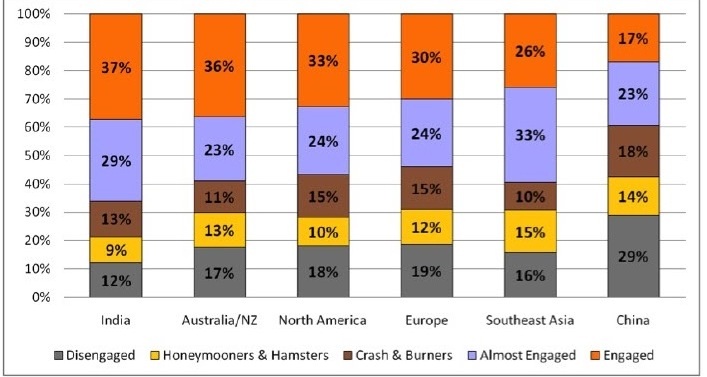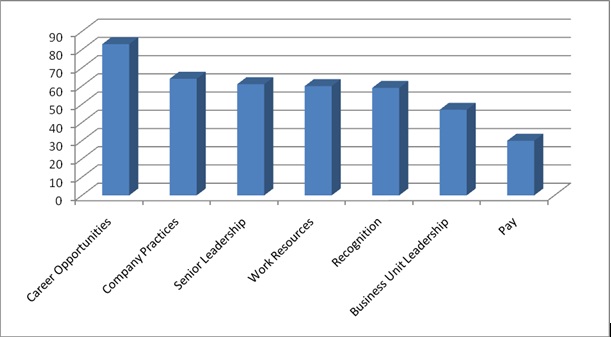Employee Engagement - Employing & Fostering Productive Workforce
Last year faced a deluge of strikes - the Maruti strike, the Bosch strike, the Coal India strike, the endless Air India strike to name a few. With a demand to form a separate union by workers at a particular plant, continued on workers dissension to sign a ‘good-conduct bond’ as directed by the management, the Maruti strike flunked to achieve anything significant except causing the company to lose on critical sales.

In the Bosch strike, workers protested against the purported outsourcing of auxiliary activities by the management. The workers accused management for them changing their stance and recantation from promises of not doing so. This strike too ended without any agreement and the case has been summoned for adjudication.
In both these cases the disengagement of employees was obvious. It was apparent that a grave lack of trust and low engagement was a bigger reason for these strikes, than any other cited by the workers or the management.
Clearly, the need of the hour is to keep employees motivated, inspired and engaged with the organization not only to create an environment of harmony at workplace but also to improve the productivity of the employees.
Here a latest cant called “Employee Engagement” comes to rescue. It is rapidly gaining popularity, use and importance in the workplace and is impacting organizations in many ways.
Engagement at work was conceptualized by Kahn (1990), as the ‘harnessing of organizational members’ selves to their work roles. In employee engagement, people employ and express themselves physically, emotionally, and cognitively during role performances.
Employee Engagement is a combination of commitment to the organization and its values plus a willingness to help out colleagues.
Employees in almost every workplace can be bifurcated into four categories: highly engaged, engaged, disengaged and highly disengaged.
While engaged employees contribute to the optimum, the disengaged ones just follow the routine. Those who are highly disengaged, go to the extent of disrupting the normal functioning.
It has been found that fewer than 1 in 3 employees worldwide (31%) are engaged. Nearly 1 in 5 (17%) are actually Disengaged. Engagement levels vary by region from 37% in India to 17% in China.
(Source: http://www.bs-muc.de/aktdoku/report.pdf)

Employee engagement is vital to any company that seeks to retain their valued employees. The Watson Wyatt consulting companies proved that there is an intrinsic linkage between employee engagement, consumer loyalty, and profitability. As the organizations are globalizing and are becoming more dependent on technology in a virtual working environment, the need to connect and link with employees in order to provide them with an organizational ‘identity’ is greater.
With attrition across different sectors touching double-digits, retention through novel forms of employee engagement has become essential. In 2010-11, attrition in the telecom sector was at 20% -23%; in ITeS, it ranged somewhere between 29% - 55%; 24% in IT; 13% in manufacturing, and12% in FMCG, according to Pune based executive search firm Absolute HR International. In such a competitive hiring market, where supply is limited and every component of salary becomes bait, getting employees to structure their take-home makes them feel wanted.
Today many companies are incorporating this tool called employee engagement to increase the level of engagement or job satisfaction of their employees. Infosys for example, has started its Infosys SocialEdge Employee Engagement Platform, which improves workforce productivity and efficiency, deepens employee engagement, and enables faster innovation by connecting and engaging with employees. It includes a range of employee engagement initiatives: Skill Management, Employee Network Management, Employee On-boarding, Sales Collaboration, Knowledge Networks, Alumni Networks etc.
Tata AIG General Insurance Co. Ltd follows a systematic sustainable & participative model by actively involving employees, soliciting ideas and encouraging employee involvement. They conduct Employee Engagement Activities like annual celebration, the success matrix, sports tournaments etc where they touch the employees and their family in the various forms.
Employee Engagement Program at HYUNDAI incorporated various systems like-Whistle-blowing system, Ombudsperson system, Gift & Entertainment approval/reporting system, Competitor Contact approval/reporting system, Conflicts of Interest approval/reporting system, Compliance Plaza, Compliance Review Board, Collection of acknowledgement from employees, Evaluation system to bring the employees in the state of satisfaction, passion and commitment.
We can see the various Engagement drivers across the companies:-

There are 3 C’s to earn true employee engagement:
Career: To give employees, the opportunity to enhance their career through promotions, change in roles and responsibilities and significant assignments are the most important needs of employees. Employees will unquestionably feel engaged if the company and its managers devote meaningful and genuine time in helping the employees move ahead in their careers.
Competency: While career is all about actual growth, competency is about the ability to grow. Competency grows with the opportunities to learn and employ the learning in real life tasks. Most employees today look for competence-boosting chances. They would like to learn, stretch and improve as long as they feel they are improving on their marketable skills.
Care: Caring is an art that demands managers to be tender, empathic and spontaneous. Not necessarily by the grand policies of company, the caring can also be experienced by small day-to-day gestures of manager. The managers should be sensitive to the 'mood' of their employees, should know employees workload, and should do something about easing their stress. There are many day-to-day gestures that constitute caring - which no investment in ostentatious gyms and food courts can replace. Caring can be considered as a culture that big companies nurture through sensitive managers who counterbalances tasks well with relationships.
A highly engaged employee will deliver beyond expectations. As rightly said by Mr. Clarence Francis (Chairman- General foods) - “You can buy a man’s time, you can buy a man’s physical presence at a given place; you can even buy a measured number of skilled muscular motions per hour or day; but you cannot buy enthusiasm, you cannot buy initiative; you cannot buy loyalty; you cannot buy devotion of hearts, minds and souls. You have to earn these things.” An organization should thus recognize employees, more than any other variable, as powerful contributors to a company's competitive position. Therefore employee should engage in a continuous process of learning, improvement, measurement and action.
This article has been authored by Saumya Dani from IIT Roorkee.
Image(s): FreeDigitalPhotos.net
Views expressed in the article are personal. The articles are for educational & academic purpose only, and have been uploaded by the MBA Skool Team.
If you are interested in writing articles for us, Submit Here
Share this Page on:
What is MBA Skool?About Us
MBA Skool is a Knowledge Resource for Management Students, Aspirants & Professionals.
Business Courses
Quizzes & Skills
Quizzes test your expertise in business and Skill tests evaluate your management traits
All Business Sections
Write for Us